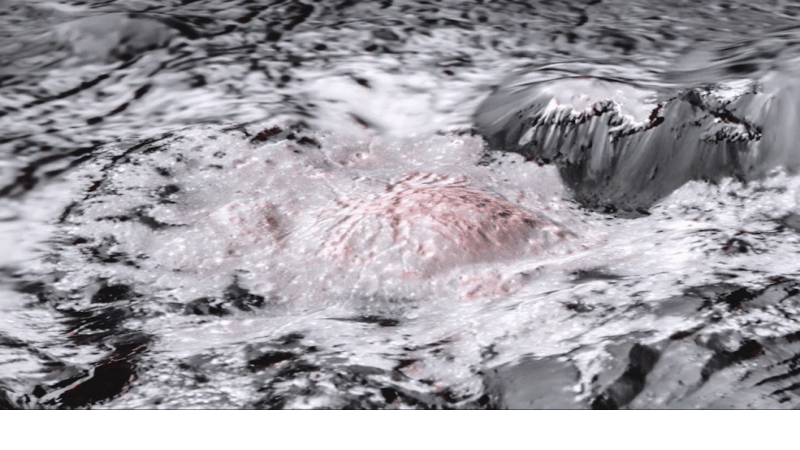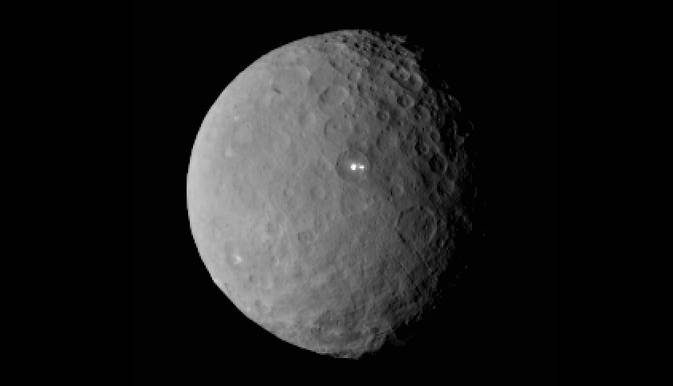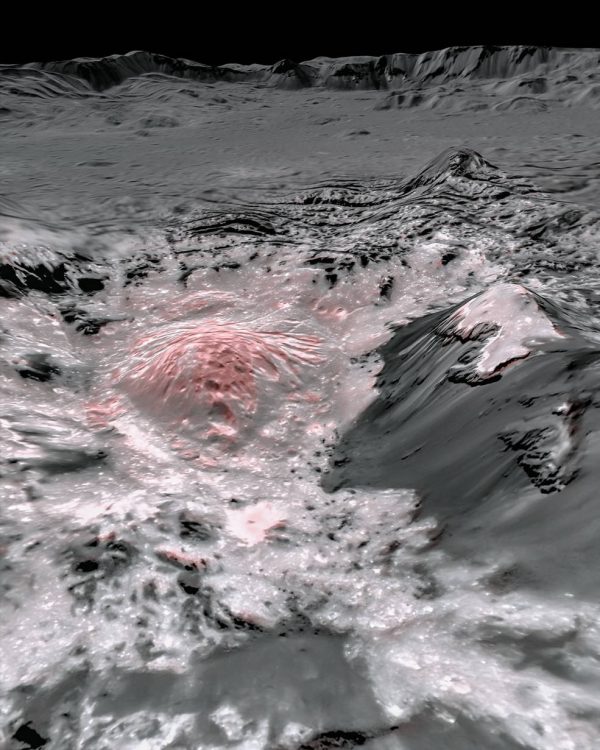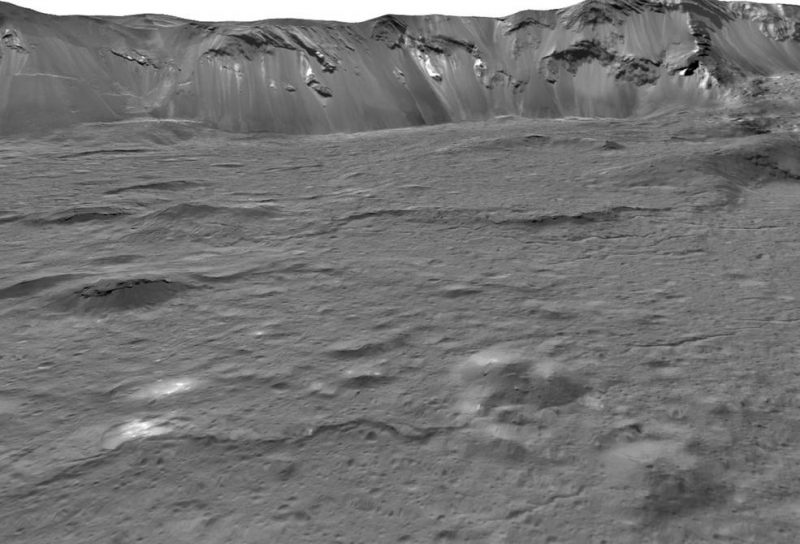
As the Dawn spacecraft was approaching Ceres in 2015, it spied some mysterious bright spots on the surface of this dwarf planet. Something on Ceres was so highly reflective that, for a time, onlookers joked about alien lights. Scientists were puzzled at first, wondering what was causing the reflectivity. It turned out there are multiple bright spots on Ceres, and they’re now known to be salt deposits on this little world’s surface, mostly composed of sodium carbonate. Scientists said the spots likely came from liquid that had percolated up to Ceres’ surface and evaporated, leaving behind a salt crust. But percolated up from where? In October 2018, as Dawn’s mission was ending, the spacecraft dipped to less than 22 miles (35 km) above Ceres’ surface. The craft saw new details in the bright areas that have now enabled scientists to explain the bright spots’ origins.
Dawn scientists now say that the salty liquid on Ceres’ surface came from a reservoir of brine, or salt-enriched water, deep in Ceres’ interior. Scientists say this brine reservoir is about 25 miles (40 km) deep and hundreds of miles wide. Ceres itself is less than 600 miles across (1,000 km) across. So, in other words, Ceres is now understood to have a relatively vast interior reservoir of briny water.
The findings, which also reveal the extent of geologic activity in Occator Crater – home of Ceres’ most famous bright spots – appear in a special collection of papers published by Nature Astronomy, Nature Geoscience, and Nature Communications on August 10, 2020.



Ceres – reclassified as a dwarf planet by the International Astronomical Union (IAU) in 2006, at the same time Pluto was demoted from full planet status – was formerly called asteroid Ceres and was the first asteroid to have been discovered in 1801.
There were hints of bright regions on Ceres long before Dawn’s arrival in 2015. Peering through telescopes, scientists had noticed diffuse bright areas of an unknown nature on the dwarf planets. The scientists’ statement said they:
… knew that micrometeorites frequently pelt the surface of Ceres, roughing it up and leaving debris. Over time, that sort of action should darken these bright areas. So their brightness indicates that they likely are young. Trying to understand the source of the areas, and how the material could be so new, was a main focus of Dawn’s final extended mission, from 2017 to 2018.
From its close orbit, Dawn captured detailed images of two distinct, highly reflective areas within Occator Crater, which were subsequently named Cerealia Facula and Vinalia Faculae (“faculae” means bright areas).
The research not only confirmed that the bright regions are young, some less than 2 million years old. It also found that the geologic activity driving these deposits could be ongoing. This conclusion depended on scientists making a key discovery: salt compounds (sodium chloride chemically bound with water and ammonium chloride) concentrated in Cerealia Facula. The scientists explained:
On Ceres’ surface, salts bearing water quickly dehydrate, within hundreds of years. But Dawn’s measurements show they still have water, so the fluids must have reached the surface very recently. This is evidence both for the presence of liquid below the region of Occator Crater and ongoing transfer of material from the deep interior to the surface.
In our solar system, icy geologic activity happens mainly on icy moons, where it’s driven by their gravitational interactions with their larger planets. But that’s not the case with the movement of brines to the surface of Ceres, because this little world isn’t particularly near any large bodies in space that might be pulling on it. Instead, the scientists found two main pathways that allow liquids from Ceres’ interior to reach its surface. Dawn principal investigator Carol Raymond said:
For the large deposit at Cerealia Facula, the bulk of the salts were supplied from a slushy area just beneath the surface that was melted by the heat of the impact that formed the crater about 20 million years ago. The impact heat subsided after a few million years; however, the impact also created large fractures that could reach the deep, long-lived reservoir, allowing brine to continue percolating to the surface.
The discovery of this presumably ongoing activity on Ceres – this movement of briny water from its interior to its surface – suggests that other large ice-rich bodies in our solar system that are not moons might also be active.

Dawn is the only spacecraft ever to orbit two extraterrestrial destinations: Ceres and the giant asteroid Vesta. This dual mission was made possible by Dawn’s ion propulsion system. The scientists’ statement explained:
When Dawn used the last of a key fuel, hydrazine, for a system that controls its orientation, it was neither able to point to Earth for communications nor to point its solar arrays at the sun to produce electrical power. Because Ceres was found to have organic materials on its surface and liquid below the surface, planetary protection rules required Dawn to be placed in a long-duration orbit that will prevent it from impacting the dwarf planet for decades.
Dawn mission director Marc Rayman of NASA said in a statement:
Dawn accomplished far more than we hoped when it embarked on its extraordinary extraterrestrial expedition. These exciting new discoveries from the end of its long and productive mission are a wonderful tribute to this remarkable interplanetary explorer.

Bottom line: Scientists studying data from spacecraft Dawn now say that the salt deposits on Ceres’ surface came from a reservoir of brine, or salt-enriched water, deep in the dwarf planet’s interior. This brine reservoir is estimated to be about 25 miles (40 km) deep and hundreds of miles wide … remarkable on a little world less than 600 miles (1,000 km) across.











